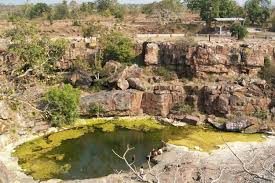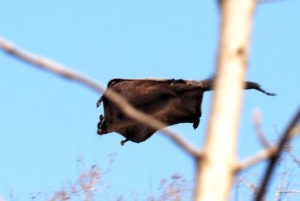Location, Area & Administration of Pratapgarh:
Pratapgarh is situated in the south-eastern part of Rajasthan, located at 24.03° N 74.78° E with an average elevation of 580 meters. It is surrounded by Udaipur, Banswara and Chittorgarh districts of Rajasthan and Ratlam, Mandsaur and Neemuch districts of Madhya Pradesh.
Pratapgarh has an area of 4,117 square meters, which is divided into 5 tehsils, namely , Arnod, Chhoti Sadri, Dhariawad, Peepal Khoont and Pratapgarh.

History of Pratapgarh:
In the 14th century, Maharana Kumbha (1433–1468) ruled ruled mewar with capital at Chittorgarh. Due to a dispute, Kumbha expelled his younger brother Kshemkarn (1437–1473), from his territory. Kshemkarn’s family too refuge in the Aravali ranges, in the southernmost part of Mewar regime.
In 1514, Kshemkarn’s son Prince Surajmal (1473–1530) became the ruler of Devalia (Devgarh) and established his capital of ‘Kanthal-Desh‘ at Dewaliya (also called Devgarh).
As the climate of Devgarh was not found to be suitable by the royal family, one of the descendants of Surajmal, Maharawat Pratapsingh of 10th generation (1673–1708) started to build a new town near native village Devgarh in 1689–1699 and named it as Partapgarh,
At that time, the area of Pratapgarh was reported to be about 889 square miles, whereas Dhariyawad, another small town near Pratapgarh, was founded by Rana Sahasmal, the grandson of legendary Maharana Pratap in the mid 15th century.
Rulers of Pratapgarh:
- Soorajmal (1473–1530)
- Founded Dewaliya, predecessor to Pratapgarh.
- Bagh Singh (1530–1535),
- Rai Singh (1535–1552),
- Vikram Singh (1552–1563),
- Tej Singh (1563–1593),
- Bhanu Singh (1593–1597),
- Singha (1597–1628),
- Jaswant Singh (1628)
- Hari Singh (1628–1673)
- Maharawat Pratap Singh (1673–1708),
- Founder Pratapgarh
- Prithwi Singh (1708–1718),
- Sangram Singh (1718–1719)
- Ummed Singh (1719–1721)
- Gopal Singh (1721–1756)
- Saalim Singh (1756–1774)
- Obtained written permission from the then Mughal king Shah Alam II to introduce a local currency for his state and named it as Saalimshahi-Sikka (coin), which was made in a local mint-(Partabgarh-Taksal).
- Maharawat Saamant Singh (1774–1844)
- North-western part of this region had very dense forests, a separate state forest department in 1828, was created to manage state’s exceptionally rich forest-wealth.
- Maharawat Dalpat singh (1844–1864)
- Maharawat Uday Singh (1864–1890)
- Introduced some reforms, established civil courts, started relief works during the notorious Great Famine of 1876-78, opened fair price shops for the citizens and also exempted certain civilian taxes.
- Uday Singh built a new palace in Pratapgarh for himself in the year 1867 AD more or less on the lines of those built by the Britishers and started living there.
- Maharawat Raghunath Singh (1890–1929)
- Maharawat Sir Ram Singh (1929–1940)
- Ambika Pratap Singh (1940–1948)
- Who lives in Pune after leaving his native place.
Just after the independence of India in 1947, the princely state of Pratapgarh agreed to join Union of India on a condition that it must be declared as newly independent district in Rajasthan. Pratapgarh remained as an independent district between 1948 and 1952. However, due to reconstitution of district boundaries, Pratapgarh became part of the Nimbahera district and then of Chittorgarh.
After 56 years, On 26th January, 2008 Pratapgarh was announced to be an 33rd independent district of Rajasthan after taking Pratapgarh, Arnod and Chhoti Sadri tehsils from Chittorgarh district, Peepal Khoont from Banswara district and Dhariyawad from Udaipur district.
Historical Places of Pratapgarh:
Devgarh
 Devgarh is located in Pratapgarh sub-divsion on a small hill. It is also known as “Devliya”. This palace is surrounded by small hills and situatated at average elevation of 1809 feet from sea level. Rajmahal, old Bawadia, Jain temples are located in Devgarh. A famous temple of “Beejamata” is also situated here, where a fair takes place every year.
Devgarh is located in Pratapgarh sub-divsion on a small hill. It is also known as “Devliya”. This palace is surrounded by small hills and situatated at average elevation of 1809 feet from sea level. Rajmahal, old Bawadia, Jain temples are located in Devgarh. A famous temple of “Beejamata” is also situated here, where a fair takes place every year.
A temple of lord Raghunath is placed in Rajmahal itself, where a solar clock is placed on the top of it. The clock tells time according to the light of sun. The Palace and its vicinity also contain some ponds including Tejsagar and Sonela.
Bhanwar Mata Temple
Bhanwar Mata temple was built by King Gori of “Manvaiyani genus” in year 491 AD. Temple is also known as “Bhanwar Mata Shakti Peeth”. It is located in Chhoti Sadri Teshsil of Pratapgarh district.
Culture of Pratapgarh:
Thewa Art:
 Thewa is a special art of jewelry making which involves embossing of intricately worked-out sheet gold on molten glass. It evolved in Pratapgarh. Its origin dates back to the Mughal age. Thewa is a traditional art of fusing 23K Gold with multi-coloured glass. The glass is treated by a special process to have glittering effects, which in turn highlights the intricate gold work.
Thewa is a special art of jewelry making which involves embossing of intricately worked-out sheet gold on molten glass. It evolved in Pratapgarh. Its origin dates back to the Mughal age. Thewa is a traditional art of fusing 23K Gold with multi-coloured glass. The glass is treated by a special process to have glittering effects, which in turn highlights the intricate gold work.
Nathu ji Soni invented the process; the secrets of the craft that passed directly from father to son over the generations remains it in the family only, who call themselves ‘Raj-Sonis’. Many of the members from this family have been awarded by UNESCO, National & State Government.
Fairs & Festivals of Pratapgarh:
The major fairs of this region are- Ambamata Fair, Sita Mata Fair, Gautameshwara Fair (on ‘Vaishak-Poornima’) and Bhanwar Mata Fair. Fairs on stipulated dates are also held in small places like Shaulee-Hanumanjee, Gangeshwara-Parsola, Manaa-Gaon, and Gupteshwara Mahadev in and around Pratapgarh.
- Doondhotsava is celebrated on Holi. The people of city do not celebrate “Dhulendi’ on the following day after Holi , but Dhuledi is celebrated thirteen days after on the hindu day of “Rang Teras”.
- ‘Gair‘-Dancers can be seen all over the villages during ‘Dashaamaataa‘ festival.
- A procession of folk-God Baba Ramdevji is a regular feature on ‘Bhag-Dashmee Teej‘.
- ‘Sheetalaa Saptmee‘ is also observed in the district, when only “Makki-Dhoklas” (cooked before a day prior to the festival) are consumed.

Geography of Pratapgarh:
The district is characterized by undulating topography. The topography of the area is undulating because of the confluence of three different geological formations- Malwa Plateau, Vindhyachal Hills and Aravali ranges. The western, and southern parts are generally plain area. Hills are scattered in Chhoti Sadri, Dhariawad, Peepalkhoont and Pratapgarh tehsils.
The soil is mainly highly fertile Black Cotton Soil made of magma of volcanos.
The major rivers of the district are Jakham, Mahi, and Siwana or shiv. Other seasonal rivers are Som, Era, and Karmoi.
The climate of Pratapgarh is characterized by Sub-tropical dry climate with distinct hot summer, cold winter and rainy monsoon. The highest temperature goes avove 43°C in May-June and the lowest up to 6 °C in December-January. The district also experiences average rainfall during the period from June-September
Natural Places in Pratapgarh:
Sita Mata Wildlife Sanctuary:
 The thickly wooded Sita Mata Wildlife Sanctuary sprawls over both the Aravali ranges and the Malwa plateau, with three seasonal rivers flowing through the forest. It covers 423 square km area of mainly dry deciduous vegetation and has exceptionally rich flora and fauna.
The thickly wooded Sita Mata Wildlife Sanctuary sprawls over both the Aravali ranges and the Malwa plateau, with three seasonal rivers flowing through the forest. It covers 423 square km area of mainly dry deciduous vegetation and has exceptionally rich flora and fauna.
It is the only forest region, where more than half the trees are high building value teak. Salar , Tendu, Bad, Peepal , Neem , Amla, bamboo, Sindoor, chironjee, Rudrakshaand Bel trees are found in abundance. The key fauna of the sanctuary are leopard, hyena, jackal, fox jungle cat, porcupine, spotted deer, wild bear, four horned antelope and nilgai etc. However, Sita Mata Sanctuary is famous for flying squirrel.
Another significant place of interest in the Sanctuary 5 km from ‘Tikhi Magri‘ is ‘Lakhiya Bhata‘, where a series of prehistoric animals is engraved on rocks.
Jakham Reservoir
Jakham Reservoir is located at village Anuppura of Pratapgarh. It is constructed on river Jakham, which is tributary of river Mahi.
Natural Resources/Minerals in Pratapgarh:
Non-forest regions of Chhoti Sadri (and part of Pratapgarh and Dhariyawad) have small scale mining activities operations, extracting mainly red ochre, calcite, dolomite, quartz, feldspar and soapstone. Marble, Building-stone and Limestone are also available in small quantities. Their deposits include:
Limestone
- Limestone deposit is found in Danta-Kela-Mela area Peepal khoot tehsil and it extended to Mahi river.
- Limestone bands are also occurring near village Devla in Dhariyawad tehsil having cement grade.
Soapstone
- Soapstone is found in village Dewla, Lohagarh, Bhungapat, Ambav, Gharda of tehsil Dhariyawad.
- This soap stone is found with dolomite rock and mostly is higher grade from cosmetic to paper grade.
Red Ochre & Laterite:
- Red ochre and laterite is found near village Dhamotar, Gopalpura, Chokdi, Kalyanpura, Dongri in tehsil Pratapgarh and village Narani, Bambori, Sakaria etc in tehsil Chhoti Sadr.
- This mineral is overlaying basalt rock.
Barites:
- Barite is found near village Peepaliyakhera, Rayanpura, Kulmipura, Manpura, Bhamardai of tehsil Pratapgarh.
Marble:
- Marble is found near village Deval tehsil Dhariyawad.
- It is of white and grey in colour and blockable in nature.
Masonry Stone:
- It is occurring near village Deval, tehsil Dhariyawad near Pratapgarh and village Kesunda tehsil Choti Sadri.
- Masonry stone is mined from basalt and low grade limestone/dolomite rocks.
Population:
- The prominent language of this region is Hindi, however, “Kanthhalee-Bolee” composed of words from Malwi, Mewari and Vagdee (local dilects) is commonly spoken in villages.
- In 2011, Pratapgarh had population of 8,67,848. As of 2011, it was (may be now also) the second least populous district of Rajasthan (out of 33), after Jaisalmer.
- There was change of 22.78 percent in the population compared to population as per 2001.
- Population density of Pratapgarh district for 2011 is 195 people per km2
- Sex Ratio in Pratapgarh stood at 983 females per 1000 male.
